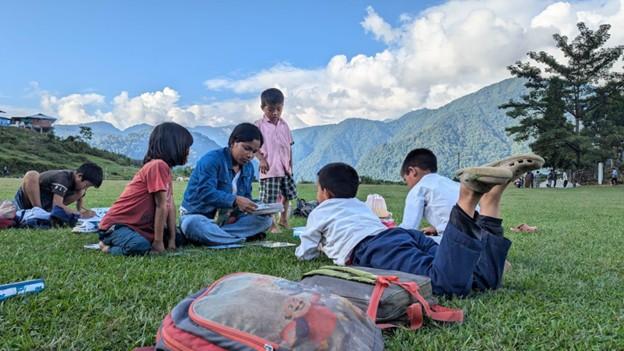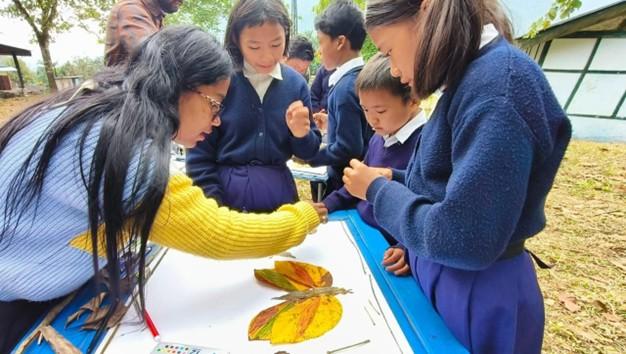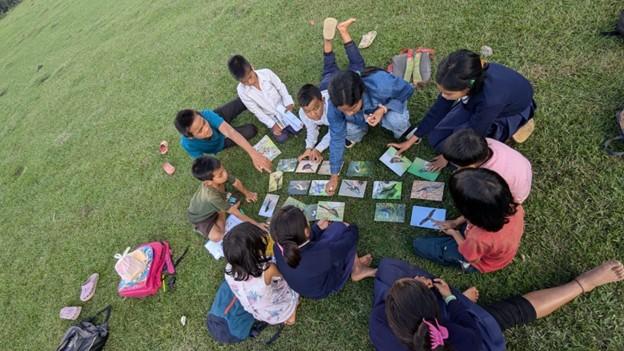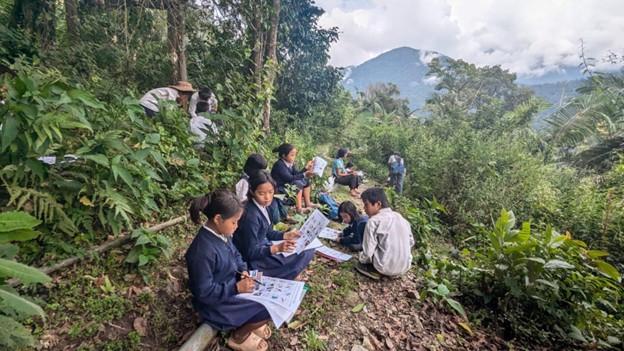Meet an Educator is a monthly series by Early Bird, where we feature the work of educators across India who are actively spreading the joy of birds and nature. This month’s featured educator is Joyshree Gogoi, a nature educator from Assam who introduces children to nature through creative activities, storytelling, and outdoor exploration, in Gobuk, Arunachal Pradesh.
Do tell us about yourself, where you are from, and your work
I am Joyshree Gogoi, a postgraduate in Social Work from Sivasagar, Assam. I have a love for Bihu dance. I was a fellow in the first batch of the Green Hub Responsible Tourism program. I work in the field of nature education, focusing on engaging children with their environment.
During my fellowship with Green Hub and Royal Enfield, the idea of Green School emerged, leading me to work in Gobuk, a village in the Upper Siang district of Arunachal Pradesh. Our initiative, Green School, introduces children to nature through creative activities, storytelling, and outdoor exploration. Our primary goal is to shift their perception of wildlife, especially birds, from hunting to appreciation and conservation.
What excites you about the natural world?
I wouldn’t call myself a birder, but after starting Green School in Gobuk and going on nature trails with children, observing birds and learning their names, I have developed some interest in them. Earlier, I knew very little about birds, but seeing the children’s enthusiasm sparked my curiosity. Now, whenever we go on trails with the children, I pay closer attention to birds–attention to birds—listening to their calls, watching them glide between trees, and identifying them along with the children. This process has not only helped the children learn but has also given me a new way to connect with nature.
There was a special moment for me when I went to Pakke for a nature education workshop and saw a hornbill for the first time. I was so happy that I can’t even explain it in words. That’s when I realized how joyful birdwatching can be.

When and how did you get interested in bird/nature education?
I was introduced to nature education during my Responsible Tourism Fellowship with Green Hub and Royal Enfield. When the idea of Green School was proposed and gained support, I realized that our work fell under nature education. Over time, my
interest deepened as I saw its impact on children. Attending a workshop at Pakke Tiger Reserve further broadened my perspective on nature education and its role in conservation. Although I entered the field without prior experience, I now see the value of engaging children with nature and encouraging them to build a positive relationship with their environment.
What do you hope to achieve through your education work?
Through my educational work, I hope that children learn about nature and start thinking about it. I want them to understand the importance of birds, animals, and the environment around them and begin to see it with love and care.

By engaging them in activities like nature trails, drawing, and storytelling, my goal is to help them see nature in a new way. Through Green School, we aim to change children’s perspectives on birds and nature. In Gobuk, bird hunting is common among children, and our goal is to shift this mindset by fostering an appreciation for wildlife. By engaging children in nature-based activities, we hope to create awareness about the role of birds in the ecosystem. Our sessions focus on interactive learning through games, storytelling, movie screenings, and nature walks. We also involve the community by spreading awareness through the children. Over time, we hope these small steps will lead to a long-term shift in attitudes toward nature conservation.
Currently, we have added three new trails in Gobuk focused on edible plants. These trails were identified in collaboration with women from Self-help Groups (SHG). We hope that the SHG members will guide children on these trails and teach them about edible plants. Through this, we aim to help children learn more about plants and their uses. Additionally, it will contribute to documenting the edible plants found in Gobuk.
Why do you believe it is important for children to learn about birds or connect with nature?
Connecting children with nature helps them develop a sense of responsibility for their surroundings. Learning about birds and other wildlife makes them aware of the role these species play in the ecosystem. By engaging with nature at an early age, children gain a better understanding of conservation and sustainability. This awareness can influence their decisions as they grow, ensuring they respect and protect the environment.
Hands-on activities like birdwatching and nature walks help them develop observation skills and curiosity. Encouraging children to appreciate nature is an important step in fostering a community that values biodiversity and environmental protection.

What tools or resources have helped you in teaching about birds? Can you describe an approach that has worked exceptionally well for you?
Movie screenings have been one of the most effective tools for teaching children about nature. Using a projector and laptop grabs their attention, and nature documentaries provide engaging visuals that help them understand wildlife concepts better. Another approach that works well is our nature walks. We use binoculars and bird identification brochures to make the experience interactive. Children note down bird names in their local language and later match them with their English names from the brochures.
This has helped them identify over 40 species in a single walk. Drawing sessions also reinforce their learning, as they sketch birds they have observed. We conduct nature-based games and activities every Wednesday, making learning fun and interactive. These methods have helped sustain their interest in birds and the environment.

Have you encountered a significant challenge as a bird/nature educator, how did you overcome it?
One of our main challenges is ensuring the sustainability of our initiative. Since we are working in a remote village, finding local individuals to take the initiative forward after we leave is difficult. Teachers appreciate our work but have not shown active involvement. While one of our team members is from the village, additional support is needed to continue the activities. Many young people from the village move away for work or education, making it hard to find long-term volunteers. We are discussing these concerns with the community and exploring ways to involve more local stakeholders.
Do share any memorable moment or experience you have had in teaching kids about birds/nature. Can you recall any insightful instance that shaped your perspective?
One day, I was talking with a child, and he was telling me about an upcoming festival. He mentioned that hunting was also a part of the festival. I asked whether they hunted only during the festival or on other days as well.
He replied that they hadn’t gone hunting for a long time and that they no longer hunt on regular days. He said, “Since Green School started, we only hunt during the festival.”
This moment stood out for me because it showed a shift in their behaviour. While hunting is still part of the festival tradition, the fact that they have reduced it in their daily lives is a significant change. It made me realize that small steps can lead to progress.
Another memorable experience was with a student who used to hunt birds with a catapult. When we first met him, he was chasing a bird, and when we asked him to stop, he questioned why he shouldn’t. Over time, through our activities, he started seeing birds differently. Now, instead of using a catapult, he observes them through binoculars. His change in behaviour was an important moment for us. Many of his friends, who used to follow him in hunting, are now also more interested in birdwatching.
One day, he found a baby bulbul caught in the rain. He recognized the bird and said, “This is a baby bulbul, it’s wet and crying.” Instead of ignoring it, he decided to rescue it. He made a small nest and placed the bird on a tree, hoping its mother would come back for it.
This moment stood out because, earlier, he would have only seen birds as targets. But now, he showed care and concern for a small, helpless bird. It was a simple yet meaningful change, showing how his perspective toward birds had shifted.

Have you noticed any changes in your learners after they received exposure to birds and nature-based learning? If yes, what are they? If not, why do you think that is?
There has been a noticeable change in the children after being exposed to birds and nature-based learning.
Earlier, some children were only interested in using catapults to hunt birds and were not very involved in Green School activities. Now, they come to us on their own, asking,
“When are we going for a trail? Can we go see birds today?” They enjoy spotting birds and telling us their names and where they are found.
They also look forward to drawing sessions and sometimes say, “If we don’t do drawing today, we won’t talk to you!” This shows their growing interest in the activities.
This change in their behavior suggests that they are becoming more engaged with nature and learning to observe birds rather than hunt them. And also , The student who was once an active hunter now spends time observing birds with binoculars.
Many other students also show a growing interest in identifying birds. They frequently ask for binoculars during their free time and use Early Bird pocket guides to recognize different species. While a few students still engage in hunting occasionally, we are hopeful that continued exposure to nature education will gradually shift their behaviour. The interest in birdwatching has increased among the students, which is an encouraging sign.
What message would you have for your fellow educators, or somebody starting out in their nature education journey?
Nature education requires patience and adaptability. It is important to have an interest in the work. Understanding the place, learning about the local lifestyle, and adjusting the approach accordingly are necessary. Building a good relationship with the villagers also helps.
Activities should match the age group and interests of the children. Some sessions may not go as planned, while others may have a bigger impact than expected. Being open to learning and trying different methods is useful. Even small changes in children’s behaviour can show progress.

